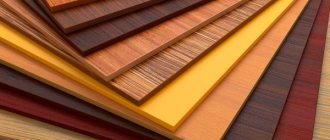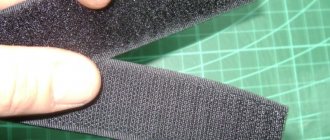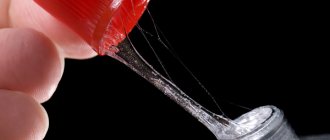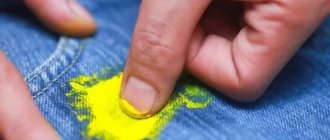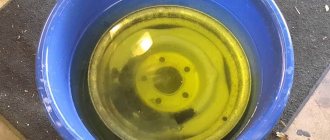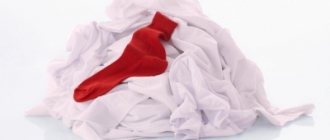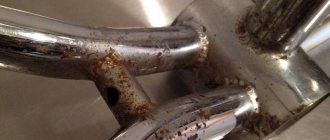Water-based paint is used to repair various rooms. The material is inexpensive, dries quickly and emits almost no odors.
In some cases, when re-repairing, it becomes necessary to remove the old layer.
How to quickly remove water-based paint from walls? There are several basic methods and certain nuances that you need to familiarize yourself with before starting work.
The need to wash off the paint
If water-based paint adheres well to the surface, it is not necessary to remove it. In this case, the new layer can be applied directly on top of the old one. However, in any case, it is necessary to clean the surface from dust and debris, as well as dry it and apply a layer of primer.
Thanks to the priming composition, an adhesive coating is formed on the surface on which the paint will adhere well. There are different types of soils, including those specifically designed for water-based compositions.
Old paint does not always adhere firmly to the surface; it may peel or bubble. In such cases, the paint layer must be washed off. It is also inevitable to remove paint in the case of a major overhaul or when it is planned to apply a completely different type of finishing material to the surface.
It is impossible to do without removing the water-based layer and, if necessary, painting with a paint composition of a sharply different color. For example, if the old layer is darker or too bright, it will probably have to be washed off.
When to shoot
There are cases in which the old coating can be left on the treated surface and situations in which the removal of the existing layer of water-based emulsion is a categorical requirement that affects the quality of subsequent work. Recent cases include:
- the need to repaint using lighter shades of paint;
- incompatibility of new and old finishing coatings;
- the presence on the treated surface of areas with swelling, swelling, peeled fragments of the previous layer;
- when carrying out capital construction work.
Among the methods used to remove finishing material, characterized by a good degree of adhesion in relation to the surfaces on which it is applied, there are: mechanical, chemical and thermal removal of the old coating.
Paint removal methods
Rinsing with water
To remove water-based paint from a ceiling or wall, you will need the following tools:
- stepladder, stable table or stool;
- wide metal spatula;
- roller (preferably with a fairly long handle);
- container (for example, basin);
- brush with metal bristles;
- polyethylene film (if there is no film, newspapers can be used);
- safety glasses, gloves and respirator.
The coating may be waterproof or non-waterproof. If a water-based coating material is resistant to moisture, it is useless to remove it with water, so in this case we will talk about washing out exclusively non-waterproof compounds.
To wash off the old layer, do the following:
- We isolate all surfaces that are undesirable to be contaminated using plastic film or newspapers.
- We put on safety glasses, gloves and a respirator.
- Pour warm water into a basin or other suitable container.
- We lower the roller into the water and run it over the paint layer that we are about to remove.
- Leave the well-wetted coating to become limp for 10-15 minutes.
- Remove the softened paint using a metal spatula.
- If the paint in some areas has not become so soft that it can be easily removed, we wet the surface again with water and work with a wire brush.
Note! There is no need to immediately wet the entire surface of a large area. There is a high probability that when the turn comes to a certain area, it will dry out by that moment.
Thermal and mechanical methods
You can also remove paint using a power tool or heat. In one case, you will need an electric drill with a grinding attachment, in the other, a hair dryer.
The sanding attachment is a round brush with metal bristles. You can buy such a device at the market or at a building materials store. Thanks to the stiff metal bristles, you can remove even thick layers of waterproof paint that cannot be washed off with water. You can also use a sander. The only significant drawback of the mechanical method is the significant amount of dust generated during operation.
The thermal technique involves using high temperature to soften the paint layer. A hair dryer is used as a device for temperature exposure. This device works on the same principle as a household hair dryer, but the air temperature is much higher.
To remove paint, heat the selected area until cracks appear in the coating. Then the cracked paint is removed with a metal spatula. We clean off the remaining paint material using sandpaper or a brush with metal bristles. Finally, thoroughly rinse and vacuum the surface.
The disadvantage of the thermal method is the need to purchase a hair dryer. It is best to rent this device from a hardware store or borrow it from friends.
Washing off waterproof paint
As mentioned above, waterproof paintwork cannot be washed off with water alone. However, if you don’t have more advanced tools at hand (hair dryer, electric drill, grinder), you can use methods that use both water and other available means.
First way:
- We will need a brush with hard metal teeth. Use a brush to make deep furrows in the paint layer.
- Next, generously moisten the scratched areas to soften the paint layer from the inside. We wait for 10-15 minutes, and then apply water to the surface again: the more the paint swells, the better. Do not forget to ventilate the room, since good air circulation in humid conditions promotes peeling of paintwork materials.
- We clean the surface from the old layer using a spatula.
Second way:
- In this case, you will need wallpaper glue or paste. Apply the adhesive composition to the old layer and a sheet of thin paper. Next, glue the paper well to the surface to be cleaned.
- Let the glue dry.
- After the adhesive has dried, remove the paper using a spatula. The paint will peel off along with the paper. We remove the remains of the old layer with sandpaper.
Recommendations
It is better to adhere to several main recommendations:
- To effectively remove paint from a wall or ceiling, it is necessary to apply water to a small area, otherwise the surface will dry out quickly, which will lead to the mandatory repetition of the procedure;
- If paint gets on furniture, remove it quickly, without waiting for it to dry completely;
- If paint gets on clothing, it must be washed with water or blotted with a napkin.
If you follow all the above tips, washing off water-based paint will be quick and easy.
Expert advice (2 videos)
Methods for removing paint stains (22 photos)
Other surface cleaning methods
In addition to those described above, there are alternative methods for removing water-based paint:
- Cleaning with chemicals. An example is iodine, 200 milliliters of which are added to water. You can also use a soap solution. The paint will swell faster if you add alcohol or salicylic acid to the solution. The fact is that alcohol actively dissolves acrylates. Latex coatings dissolve due to exposure to chloroform and dichloroethane compounds. However, we should not forget about the toxicity of these substances and the need to use protective equipment (gloves, goggles, respirator), as well as room ventilation.
- You can hide the layer of old paintwork behind a suspended or suspended ceiling, as well as behind decorative panels. Of course, this method is only applicable if the ceiling height is sufficient.
- You can also wash off the old layer using a paint destroyer. This jelly-like substance should be treated with the desired area and wait for the time specified by the manufacturer on the packaging. Next, the material is treated with solvent 646 and removed with a metal spatula. The advantage of the technique is the absence of dust pollution, but the disadvantage is that it is quite time consuming.
- In addition to destroyers, there are special washes. Such a substance is a liquid that includes dimethyl chloride solvent, isopropyl alcohol, formic acid or some other organic component. Per square meter of surface you will need approximately 200 grams of washing liquid.
Use of solvent and its derivatives
Like all paints, water-based paint can be easily removed with a solvent. Such compositions are often used to treat walls before painting. Even if the old film is quite thick, it can be quickly removed with the following substances:
- isopropyl alcohol;
- solvent;
- formic alcohol;
- white spirit.
Such compounds are quite toxic, so it is advisable to work with them in personal protective equipment. Use respirators and special glasses to protect your eyes and respiratory organs.
Chemicals for cleaning
There are many cleaning compounds on the market, but not all of them are suitable for treating indoor surfaces, as they are highly toxic. Among the compositions intended for interior work, the following can be distinguished:
- "Set Boya Sokucu" made in Turkey. The remover helps soften the paint layer on concrete, wood and metal surfaces. "Set Boya Sokucu" is not compatible with plastic, as it corrodes the material. The composition is applied to the surface for 15-20 minutes. After the waiting period, the remaining paint is removed with a spatula. Cleaning is completed by treating the surface with a cellulose-based solvent.
- Cleaning composition “Usadba”. The substance looks like a gel paste and can be used to remove water-based coatings from any surface except plastic. The paint softens within about 10-15 minutes after applying the remover. The gel is characterized by safety for human health. At the end of the process, it is necessary to finish the material with some kind of degreaser.
If you want to remove paint from plastic without damaging the surface, you must take into account that different chemical compositions are used for each type of plastic.
How to wipe it off clothes
Before you start removing stains from clothes, study the characteristics of the fabrics from which they are made and only then turn to cleaning products. The most optimal options are the following:
- A fresh stain that has just formed on jeans or a sweater can be easily removed by rubbing the item in warm water. Then all that remains is to rinse off the remaining coloring composition under the tap.
- A slightly stubborn stain can be removed with kerosene. It is enough to moisten the contaminated area and rub lightly. Then you need to put the item in the washing machine and wash it thoroughly with washing gel concentrate.
- The vinegar solution will help remove fairly deep and old stains. To prepare, you need to take 100 ml of water and vinegar. Mix the two ingredients and add a tablespoon of table salt. Apply the prepared solution to the stain and leave for 15 minutes. Wash the item in the standard way.
A vinegar solution will help remove even deep stains from clothes Source vse-otoplenie.ru
Such cleaning options are suitable for almost all types of clothing and are considered harmless.
Cleaning paint from debris
When carrying out repair work, debris often gets into the container with fresh paintwork. This usually happens due to insufficiently thorough removal of dirt from the surface or tool. You cannot use contaminated paintwork materials, since in this case it is impossible to ensure proper quality of painting. Water-based paint is not cheap, so instead of buying a new can, it is better to remove any debris from the container. This is done as follows:
- We remove large pieces of debris by hand or, for example, with tongs. We remove medium-sized particles with a sieve.
- If you accidentally mix paints and varnishes of different colors, stir them well. Next, take a suitable color in the required volume and slowly add it to the solution. The goal is to return the paint to its original color. However, it is worth noting here that tinting is only possible in a situation where we are dealing with compositions of the same type. For example, you should never mix oil and acrylic paints.
- Debris can also penetrate quite deeply onto a painted surface. In this case, cleaning the problem area with fine-grain sandpaper will help. Another layer of paint material is then applied to the cleaned area. If the dirt is too noticeable, you may have to apply a new coat of paint over the entire painted surface.
So, when choosing a method for cleaning a surface from water-based paint, it is necessary to take into account the type of paint composition: is it waterproof ? The simplest way to remove the old layer is to wash it off with water, and the most technologically advanced way is to use special chemicals.
Professional tool
This could be a sanding machine for construction work. You can replace this tool with a drill or screwdriver. A special attachment for grinding is put on the head of the device, which, when started, begins to actively rotate and remove paint mechanically. For this procedure, the surfaces are not wetted.
A sander will remove water-based emulsion paint professionally Source ftool.ru
Advice from professionals
The soap solution is suitable for water-based paint with a non-waterproof composition. It's easy to check - wet a small area and wipe with a sponge. If stains appear on the wall and the dye remains on the sponge, it means that the material does not require special solvents.
Working with bar soap will be simplified if you first grate it , chop it finely, and scrape it with a knife.
Additionally, you can apply small notches to the wall (for example, with a knife or the corner of a spatula) - the softening process will go faster. The main thing is not to make the scratches too deep, so as not to damage the base of the wall.
When working with a hair dryer or other power tools, craftsmen recommend dividing the wall into sections and marking the boundaries (with a pencil or other convenient method). This approach will allow you to move in the right direction and track the cleaning stages and operating time.
If the heated composition gets from the wall to other places, it is better to immediately wipe it with a damp cloth . Otherwise, the paint will dry out again and you will have to re-treat it with a hairdryer or solvent. Professionals recommend covering all surfaces in the rooms - with newspaper, film, rags.
Mopping the ceiling
There are often traces left on the ceiling in the kitchen from gas combustion residues, from the evaporation of liquid during cooking, from flies and mosquitoes. To prevent it from becoming too dirty, it should be cleaned regularly. If you don’t have a stepladder, you can use a special mop with a long handle and a rotating mechanism.
First, treat the most contaminated surfaces with soda or saline solution. The soft cloth should then be rinsed thoroughly in clean water. After squeezing out excess water from a rag, wipe the entire ceiling; if necessary, the procedure can be repeated, replacing the dirty water with clean water.
If you use a cloth that is too damp, then unsightly stains may remain on the surface (especially if it is colored). After wet cleaning, the base is thoroughly wiped with a soft, dry cloth.
You can try to remove traces of mold using a special antifungal aerosol. If this does not help, then use copper sulfate, but after this the ceiling will have to be repainted.
Safe work
Cleaning the ceiling is difficult; this procedure requires special skill and takes a lot of time.
When washing the ceiling, you need to use a stepladder.
To easily reach a high ceiling, you should use a stable stepladder. It is desirable that it have a wide area for placing a container with soapy liquid.
Gloves are used to protect the skin of the hands from detergent components. To prevent cleaning solution and dust particles from getting into your eyes while working, you should wear safety glasses.
It is better not to use hard mops to avoid damaging the ceiling; it is better to use a soft cloth.
When washing, they grab small surfaces; you don’t have to reach far. It is better to rearrange the stepladder once again so as not to fall from it. It is advisable to have an assistant below who, if necessary, will provide the necessary items and provide backup.
Effective washing
To clean the ceiling effectively, you must use a soft, non-fading, lint-free cloth. Instead of fabric, you can use a foam sponge.
Wash the ceiling surface with a soft cloth.
Wipe the ceiling with gentle hand movements; you don’t need to press hard on it.
For surfaces painted with a water-based solution, do not use cleaning products that contain an abrasive substance, acid or other chemically active component.
You cannot use toxic solutions, the surface will be damaged, it will have to be renewed, and the room will need to be ventilated for a long time to remove the pungent odor.
